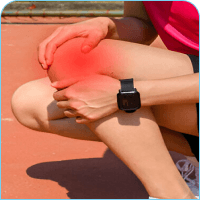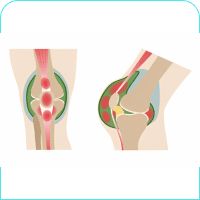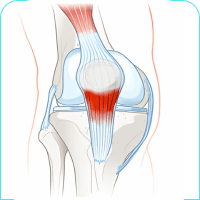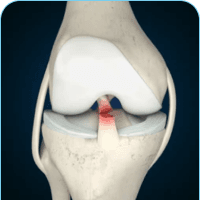Non-Surgical Knee Pain Treatment & Expert Doctors in Bangalore
Knee pain symptoms are a common problem among people of all ages. Knee pain symptoms are commonly seen due to a sports injury, a work-related injury, or an existing medical condition. The knee comprises many intricate parts, including cartilage, bone, tendons, ligaments, and fluids. The injury or irritation of even one can lead to relentless pain and even limit physical activity.


Anatomy of the Knee
Knee is the largest hinge joint of the body and is lined by an articular cartilage which is lubricated by synovial fluid. It is formed by the articulation of the distal/lower end of the femur and the the proximal/upper end of the tibia . Quadriceps tendon connects the quadriceps muscle to patella. Patellar tendon connects the patella onto the tibia. Ligaments join the bones forming the knee joint and provide stability to the knee
- The anterior cruciate ligament prevents the femur from sliding backward on the tibia
- The posterior cruciate ligament prevents the femur from sliding forward on the tibia
- The medial and lateral collateral ligaments prevent the femur from sliding side to side.
Two C-shaped pieces of cartilage called the medial and lateral menisci act as shock absorbers between the femur and tibia. Knee is surrounded by numerous bursae, which are fluid filled spaces and help in smooth movement of the knee.
Knee Pain Symptoms
Knowing the symptoms of knee pain is the first step toward appropriate intervention. The location of the pain and its severity may vary depending on the cause of the pain. Knee pain symptoms include.
Swelling and stiffness
Swelling refers to the bulge around the knee that causes pain when applied. Various causes, such as injury, sudden movements, or strain can cause stiffness in the knee. Swelling and stiffness in the knee cause inflammation, leading to reduced mobility.
Redness and warmth to the touch
Redness and warmth to the touch around the knee, especially if accompanied by pain and swelling, can indicate inflammation or infection and require prompt medical attention.
Weakness or instability
Knee pain accompanied by weakness or instability can indicate various issues, including ligament tears, cartilage damage, or knee cap instability.
Popping or crunching noises
Popping or crunching in the knee are known as crepitus and indicate issues such as cartilage wear, arthritis, or even meniscus tears. They should be evaluated by the doctor if accompanied by pain and swelling.
Inability to fully straighten the knee
The inability to fully straighten the knee and other symptoms such as pain, inflammation, and stiffness can indicate meniscus tear, arthritis, or ligament injuries.
Kneecap Dislocation
Kneecap dislocation happens when the front portion of the knee, known as the patella, slips out of place. In some cases, the kneecap may stay displaced, causing pain in the knee.
Improper Waking Posture
Walking in a wrong or incorrect posture may lead to pain in the hip and foot and in turn may cause pain in the knee joint. Due to incorrect posture while walking, it may strain the muscles surrounding the knee and cause pain.
Knee Joint Conditions
- Osteoarthritis: Degeneration of joint cartilage leading to pain and stiffness.
- Rheumatoid arthritis: An autoimmune disorder causing joint inflammation.
- Patellar tendinitis: Inflammation of the tendon connecting the kneecap to the shinbone.
- Bursitis: Inflammation of the bursae, the small fluid-filled sacs cushioning the knee joint.
Causes of Knee Pain
- Overuse
- Arthritis
- Injuries
Overuse
- Patellofemoral pain (PFPS or runner’s knee).
- Osgood-Schlatter disease (jumper’s knee) — only in kids and teens.
- Tendinitis (especially patellar tendinitis).
- Bursitis (especially prepatellar bursitis).
Arthritis
- Osteoarthritis
- Rheumatoid arthritis
- Post-traumatic arthritis
Injuries
- Repetitive strain injuries.
- Sports injuries.
- Traumas like falls or car accidents.
- Knee sprains
- Hyperextended knees
- Knee ligament tears
- Meniscus tears
- Broken Bones
- Dislocations
Knee Pain Diagnosis: When to See a Doctor
- Inability to bear weight or a feeling of instability.
- Significant swelling or visible deformity.
- Fever accompanying redness and warmth, suggesting infection.
- Persistent pain is unresponsive to initial self-care measures.
Treatment for Knee Pain Without Surgery
- Physical Therapy: Customized exercises to strengthen muscles around the knee, enhancing stability and flexibility.
- Medications: Use non-steroidal anti-inflammatory drugs (NSAIDs) to alleviate pain and reduce inflammation.
- Injections: Corticosteroid injections to decrease inflammation or hyaluronic acid injections to lubricate the joint.
- Lifestyle Modifications: Weight management and activity adjustments to reduce stress on the knee joint.
- Assistive Devices: Utilizing braces or orthotic inserts to support the knee and correct biomechanical issues.
Why Choose Alleviate Pain Clinic For Knee Pain Treatment?
Alleviate Pain Clinic specializes in knee pain treatment without surgery and offers knee pain treatments tailored to individual needs.
Our approach includes:
- Comprehensive Evaluation: Thorough assessments to identify the root cause of knee pain.
- Personalized Knee Pain Treatment Plans: Combining physical therapy, medications, and advanced injection therapies.
- Expert Team: A multidisciplinary team dedicated to providing compassionate and effective care.
For more information on our services, visit our website: Alleviate Pain Clinic.
Understanding knee pain symptoms and its management options empowers individuals to seek appropriate care, enhancing mobility and quality of life.














